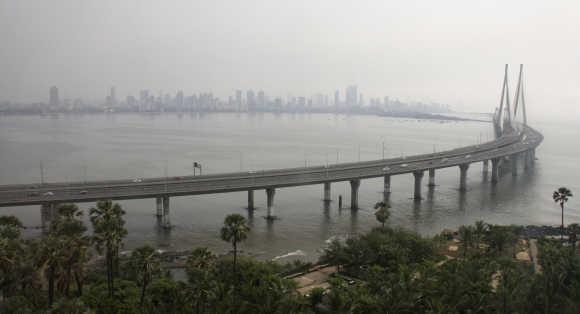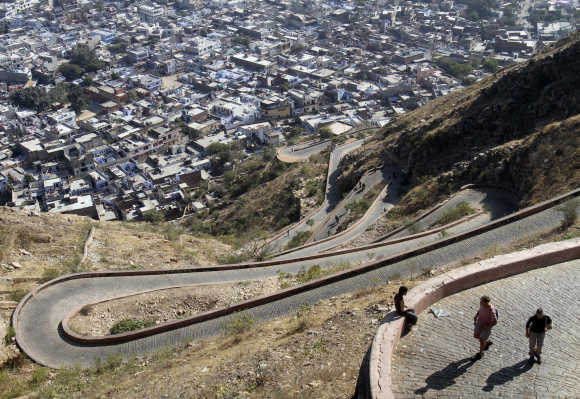 | « Back to article | Print this article |
India should accept days of 9% growth are over
India has no god-given right to foreign capital. Investors will have to accept the effects of a weaker macro-economy, says Akash Prakash.
The "new normal" was a term coined by Pimco to describe their outlook for the US economy post the financial crisis.
They use the term to describe a muddle-through type of economy, wherein the US will grow at one to two per cent, with the headwinds of deleveraging causing a long-term downshift in growth expectations.
India seems to be entering its own new normal, with a governance crisis causing the downshift in growth, unlike the financial crisis in the US.
Many investors still look at the golden period of 2003-08 and use that as their benchmark of what the country will deliver in the coming years.
They believe that the current slowdown is cyclical, not structural, and that we can still aspire to nine per cent GDP growth, inflation between four and five per cent, a strong investment rate of 38-39 per cent of GDP, corporate earnings growth rates of 25 per cent and declining interest rates (all features of the 2003-08 period).
Click NEXT to read more...
India should accept days of 9% growth are over
Government policy makers also seem (at least publicly) to believe that this growth scenario is still achievable.
Given the dysfunctional governance of the past few years, India and its investors have to accept a new reality of a much weaker macro.
Unless things change significantly, it looks like the new trend rate of growth for India will be around seven per cent, inflation will be stuck between six and seven per cent (given supply-side rigidities), interest rates will not come down significantly and fixed-asset investment will languish.
Both the current account and fiscal deficits will remain elevated, as we are unable to make the required decisions to get our economic house in order.
The slower growth will constrain revenue buoyancy and hence the ability to control the fiscal, while poor fixed asset investment will constrain the supply side and the focus on consumption derail the current account.
If this is the path forward it has significant implications for how investors will look at India, and how they should position their portfolios.
While investors express frustration with the current policy impasse in Delhi, most have not yet accepted this as being the new normal for India.
Will India be able to attract anywhere near the amount of capital it needs if this is the best we can do?
Click NEXT to read more...
India should accept days of 9% growth are over
All talk of India becoming a separate asset class in itself, something that China and Brazil have already achieved, will remain just talk.
Going forward if this is the new normal, some of the changes investors should expect will be as follows. Instead of the rupee strengthening, as most had come to expect in the 2003-08 period, the rupee will remain weak.
Large current account deficits, weak capital inflows and high inflation differentials will ensure this. A weakening rupee will be a real headache for those companies with large unhedged foreign currency liabilities. The all-in cost of foreign borrowings will rise.
Large foreign-currency earners will stand to gain significantly. The government will have no option but to further liberalise FII participation in local debt markets to attract flows. Expect further measures to attract NRI money. Investors will also have to build in a rupee drag in their expected dollar return calculations for Indian assets.
As interest rates remain sticky on the way down and liquidity conditions stay tight, leverage will remain a bad word.
Investors will continue to pay up for earnings and balance sheet quality.
Click NEXT to read more...
India should accept days of 9% growth are over
As the economy remains stuck in this new lower growth orbit, and rates don't ease significantly, NPA pressures on the banking system will accentuate.
Access to equity capital will get increasingly constrained for large segments of corporate India. As private-sector investment remains weak because of the poor investment climate, new greenfield capacities will not come up.
This lack of new capacity will make existing assets very profitable and they will earn supernormal returns on equity. There will be a massive premium ascribed to any company which is able to set up large greenfield projects.
It will also shift the balance of power between capital equipment suppliers and project owners. In the 2003-08 boom capital equipment suppliers made a killing, they had great business models with high ROEs, strong cashflow and massive growth.
Capital equipment suppliers were better investments than buying the company setting up the project. This will now flip, as owners of existing operational assets will make huge returns, while intense competition among capital equipment suppliers chasing few orders will decimate their profitability.
Corporate earnings are unlikely to grow at the 25 per cent cumulative annual growth rate we saw in the 2003-08 period, and ROEs will not get back to 20 per cent (we are at 16 per cent today).With market earnings growing at 15 per cent, and an ROE profile of 16 per cent, why should India get a price-equity premium to the rest of the emerging-market world?
Click NEXT to read more...
India should accept days of 9% growth are over
With RoEs down to 16 per cent and the cost of equity remaining high, the value creation spread (ROE minus cost of equity) in India has collapsed. India used to trade at a discount to the rest of the Asian EM world, and could easily go back to trading on par with these markets.
Consumption and export themes will continue to dominate market performance, and valuations in these sectors will likely expand further, as the growth mix continues to be skewed towards consumption over asset creation.
With rates remaining high and sticky, fixed-income products will continue to give stiff competition to equities, and one is unlikely to see much shift in domestic investor asset allocation towards stocks.
In an inflationary backdrop, investor fascination for gold and real estate will continue, crimping the available pool of savings in financial assets, further solidifying rates at current levels.
If the new normal does not interest investors sufficiently, how will the government finance its trillion-dollar infrastructure plan? Where will the private sector get the equity and debt to fund half of this build-out?
Click NEXT to read more...
India should accept days of 9% growth are over
India's macro outlook and story will have little fascination for most top-down macro players, who will just ignore the country.
We will go back to being a stock-picker's market, where investors search for stock-specific ideas and individual stocks do well within a range-bound market.
Just to be clear, I don't think we are destined to be stuck at this new normal. We still have the chance to turn it around. But for that we need far more coherent, decisive and inclusive decision-making coming out of Delhi and the states.
The trust deficit between the people, government and corporate India has to be bridged. Someone has to step up and play the role of a statesman and think of India's long-term economic interests.
I have rarely seen sentiment on India turn this sour, with even sensible and long-term India hands giving up. We need to turn this around or risk falling off the radar for many long-term pools of capital.
Very few people have any compulsion to be in India, we have no god-given right to attract $75-80 billion in annual capital flows. The sooner we realise this, the better.
The author is fund manager and CEO of Amansa Capital






